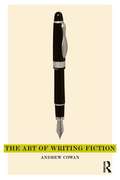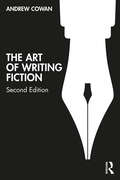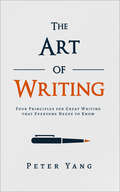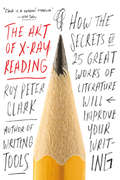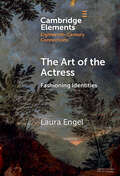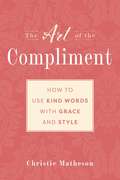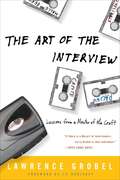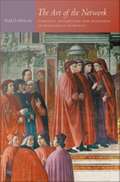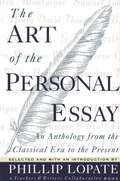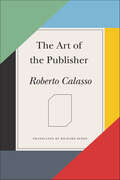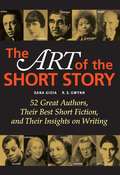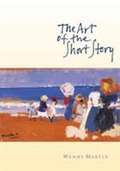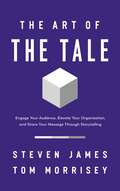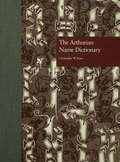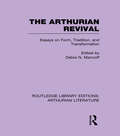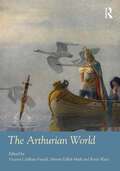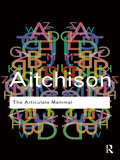- Table View
- List View
The Art of Writing Fiction
by Andrew CowanThe Art of Writing Fiction guides the reader through the processes of creative writing from journal-keeping to editing, offering techniques for stimulating creativity and making language vivid. Readers will master key aspects of fiction such as structure, character, voice and setting. Andrew Cowan provides an insightful introduction that brings his own well-crafted prose style to bear on the processes and pleasures of writing fiction, offering practical and personal advice culled from his own experience and that of other published writers. He lays open to the reader his own notes, his writing, and the experiences from his own life that he has drawn on in his fiction allowing the reader to develop their own writing project alongside the author as they go through the book.
The Art of Writing Fiction
by Andrew CowanAn elegant and intimate insight into the personal and practical processes of writing, Andrew Cowan’s The Art of Writing Fiction draws on his experience as a prize-winning novelist and his work with emerging writers at the University of East Anglia. As illuminating for the recreational writer as for students of Creative Writing, the twelve chapters of this book correspond to the twelve weeks of a typical university syllabus, and provide guidance on mastering key aspects of fiction such as structure, character, voice, point of view, and setting, as well as describing techniques for stimulating creativity and getting the most out of feedback. This new edition offers extended consideration to structure, point of view, and the organisation of time in the novel, as well as the conduct of the Creative Writing workshop in the light of the decolonising the curriculum movement. It features additional writing exercises, as well as an afterword with invaluable advice on approaching agents and publishers. The range of writers surveyed is greatly expanded, finding inspiration and practical guidance in the work of Margaret Atwood, Ayanna Lloyd Banwo, Richard Beard, Tsitsi Dangarembga, Richard Ford, Ashley Hickson-Lovence, Anjali Joseph, James Joyce, James Kelman, Ian McEwan, Arundhati Roy, Sam Selvon, Vikram Seth, and Ali Smith, among many others. With over 80 writing exercises and examples taken from dozens of novels and short stories, the new edition of The Art of Writing Fiction is enriched by the author’s own experience as a novelist and lecturer, making it an essential guide for readers interested in the theory, teaching, and practice of Creative Writing.
The Art of Writing Fiction
by Andrew CowanAn elegant and intimate insight into the personal and practical processes of writing, Andrew Cowan’s The Art of Writing Fiction draws on his experience as a prize-winning novelist and his work with emerging writers at the University of East Anglia.As illuminating for the recreational writer as for students of Creative Writing, the twelve chapters of this book correspond to the twelve weeks of a typical university syllabus, and provide guidance on mastering key aspects of fiction such as structure, character, voice, point of view, and setting, as well as describing techniques for stimulating creativity and getting the most out of feedback.This new edition offers extended consideration to structure, point of view, and the organisation of time in the novel, as well as the conduct of the Creative Writing workshop in the light of the decolonising the curriculum movement. It features additional writing exercises, as well as an afterword with invaluable advice on approaching agents and publishers. The range of writers surveyed is greatly expanded, finding inspiration and practical guidance in the work of Margaret Atwood, Ayanna Lloyd Banwo, Richard Beard, Tsitsi Dangarembga, Richard Ford, Ashley Hickson-Lovence, Anjali Joseph, James Joyce, James Kelman, Ian McEwan, Arundhati Roy, Sam Selvon, Vikram Seth, and Ali Smith, among many others.With over 80 writing exercises and examples taken from dozens of novels and short stories, the new edition of The Art of Writing Fiction is enriched by the author’s own experience as a novelist and lecturer, making it an essential guide for readers interested in the theory, teaching, and practice of Creative Writing.
The Art of Writing: Four Principles for Great Writing that Everyone Needs to Know
by Peter YangRediscover the lost art of excellent writing—a valuable skill through the ages, and even more so in the twenty-first century.Since the invention of writing, the written word has fueled humanity’s astonishing progress. Thus, the ability to write effectively and beautifully has long been revered and rewarded.And yet in the digital age, people have begun to believe that this talent is somehow obsolete: that writing is something unworthy of study beyond the basic mechanics of vocabulary and syntax and grammar, that mediocre prose is acceptable in a world crying out for clear and precise communication.Peter Yang believes otherwise.The Art of Writing is Yang’s highly practical treatise on the four key principles of dazzling, effective writing—economy, transparency, variety, and harmony. Far from your garden-variety style guide, this book offers principles that apply to everyone, whether you’re writing an inauguration speech, a novel, or a letter home to Mom.Great writing is a skill, and this book gives you the tools to make your words shimmer on the page (or the screen). Packed with real-world insights and advice, The Art of Writing is your ultimate guide to transforming your writing and unleashing your inner artist.
The Art of X-Ray Reading: How the Secrets of 25 Great Works of Literature Will Improve Your Writing
by Roy Peter ClarkRoy Peter Clark, one of America's most influential writing teachers, offers writing lessons we can draw from 25 great texts.Where do writers learn their best moves? They use a technique that Roy Peter Clark calls X-ray reading, a form of reading that lets you penetrate beyond the surface of a text to see how meaning is actually being made. In THE ART OF X-RAY READING, Clark invites you to don your X-ray reading glasses and join him on a guided tour through some of the most exquisite and masterful literary works of all time, from The Great Gatsby to Lolita to The Bluest Eye, and many more. Along the way, he shows you how to mine these masterpieces for invaluable writing strategies that you can add to your arsenal and apply in your own writing. Once you've experienced X-ray reading, your writing will never be the same again.
The Art of the Actress: Fashioning Identities (Elements in Eighteenth-Century Connections)
by Laura EngelThis Element looks at the art of the actress in the eighteenth century. It considers how visual materials across genres, such as prints, portraits, sculpture, costumes, and accessories, contribute to the understanding of the nuances of female celebrity, fame, notoriety, and scandal. The 'art' of the actress refers to the actress represented in visual art, as well as to the actress's labor and skill in making art ephemerally through performance and tangibly through objects. Moving away from the concept of the 'actress as muse,' a relationship that privileges the role of the male artist over the inspirational subject, the author focuses instead on the varied significance of representations, reproductions, and re-animations of actresses, female artists, and theatrical women across media. Via case studies, the Element explores how the archive charts both a familiar and at times unknown narrative about female performers of the past.
The Art of the Compliment: Using Kind Words with Grace and Style
by Christie MathesonA few well-chosen words can elicit smiles, inspire happiness, transform moods, and turn a bad day into a good one. Philosopher William James once said, "The deepest principle in human nature is the desire to be appreciated." This is a fun, fabulous, reader-friendly book all about compliments-the history of compliments, how to use them, best-loved compliments, and how to take them.
The Art of the Epigraph
by Rosemary AhernFor many book Lovers, there is no more pleasing start to a book than a well-chosen epigraph. These intriguing quotations, sayings, and snippets of songs and poems do more than set the tone for the experience ahead: the epigraph informs us about the author's sensibility. Are we in the hands of a literalist or a wit? A cynic or a romantic? A writer of great ambition or a miniaturist? The epigraph hints at hidden stories and frequently comes with one of its own. The Art of the Epigraph collects more than 250 examples from across five hundred years of literature and offers insights into their meaning and purpose, including what induces so many writers to cede the very first words a reader will encounter in their book to another writer. With memorable quotations ranging from Dr. Johnson to Dr. Seuss, Herodotus to Hemingway, Jane Austen to Karl Marx, and A. A. Milne to Marcel Proust, here is a book that allows us a glimpse of the great writer as devoted reader. This lively and distinctive literary companion traces not only the art of the epigraph but the history of the book.
The Art of the Epigraph: How Great Books Begin
by Rosemary AhernFor many book Lovers, there is no more pleasing start to a book than a well-chosen epigraph. These intriguing quotations, sayings, and snippets of songs and poems do more than set the tone for the experience ahead: the epigraph informs us about the author's sensibility. Are we in the hands of a literalist or a wit? A cynic or a romantic? A writer of great ambition or a miniaturist? The epigraph hints at hidden stories and frequently comes with one of its own. The Art of the Epigraph collects more than 250 examples from across five hundred years of literature and offers insights into their meaning and purpose, including what induces so many writers to cede the very first words a reader will encounter in their book to another writer. With memorable quotations ranging from Dr. Johnson to Dr. Seuss, Herodotus to Hemingway, Jane Austen to Karl Marx, and A. A. Milne to Marcel Proust, here is a book that allows us a glimpse of the great writer as devoted reader. This lively and distinctive literary companion traces not only the art of the epigraph but the history of the book.
The Art of the Interview: Lessons from a Master of the Craft
by Lawrence GrobelHighly respected in journalist circles and hailed as the Interviewers Interviewer, Lawrence Grobel is the author of well-received biographies of Truman Capote, Marlon Brando, James Michener, and the Huston family, with bylines from Rolling Stone and Playboy to the New York Times. He has spent his thirty-year career getting tough subjects to truly open up and talk. Now, in The Art of the Interview, he offers step-by-step instruction on all aspects of nailing an effective interview... Grobel reveals the most memorable stories from his career, along with examples of the most candid moments from his long list of famous interviewees, from Oscar-winning actors and Nobel laureates to Pulitzer Prizewinning writers and sports figures. Taking us step by step through the interview process, from research and question writing to final editing,The Art of the Interview is a treat for journalists and culture vultures alike.
The Art of the Network: Strategic Interaction and Patronage in Renaissance Florence
by Paul D. McleanWriting letters to powerful people to win their favor and garner rewards such as political office, tax relief, and recommendations was an institution in Renaissance Florence; the practice was an important tool for those seeking social mobility, security, and recognition by others. In this detailed study of political and social patronage in fifteenth-century Florence, Paul D. McLean shows that patronage was much more than a pursuit of specific rewards. It was also a pursuit of relationships and of a self defined in relation to others. To become independent in Renaissance Florence, one first had to become connected. With The Art of the Network, McLean fills a gap in sociological scholarship by tracing the historical antecedents of networking and examining the concept of self that accompanies it. His analysis of patronage opens into a critique of contemporary theories about social networks and social capital, and an exploration of the sociological meaning of "culture. " McLean scrutinized thousands of letters to and from Renaissance Florentines. He describes the social protocols the letters reveal, paying particular attention to the means by which Florentines crafted credible presentations of themselves. The letters, McLean contends, testify to the development not only of new forms of self-presentation but also of a new kind of self to be presented: an emergent, "modern" conception of self as an autonomous agent. They also bring to the fore the importance that their writers attached to concepts of honor, and the ways that they perceived themselves in relation to the Florentine state.
The Art of the Novel
by Milan Kundera“Incites us to reflect on fiction and philosophy, knowledge and truth, and brilliantly illustrates the art of the essay.” — The New Republic"Every novelist's work contains an implicit vision of the history of the novel, an idea of what the novel is. I have tried to express the idea of the novel that is inherent in my own novels." — Milan KunderaKundera brilliantly examines the evolution, construction, and essence of the novel as an art form through the lens of his own work and through the work of such important and diverse figures as Rabelais, Cervantes, Sterne, Diderot, Flaubert, Tolstoy, Musil, Kafka, and perhaps the least known of all the great novelists of our time, Hermann Broch.Kundera's discussion of his own work includes his views on the role of historical events in fiction, the meaning of action, and the creation of character in the post-psychological novel.
The Art of the Personal Essay: An Anthology from the Classical Era to the Present
by Phillip LopateWide-ranging selection of essays historical and contemporary writers.
The Art of the Publisher
by Roberto CalassoAn interior look at Roberto Calasso's work as a publisher and his reflections on the art of book publishingIn this fascinating memoir, the author and publisher Roberto Calasso meditates on the art of book publishing. Recalling the beginnings of Adelphi in the 1960s, he touches on the Italian house's defining qualities, including the considerations involved in designing the successful Biblioteca series and the strategy for publishing a wide range of authors of high literary quality, as well as the historic critical edition of the works of Nietzsche.With his signature erudition and polemical flair, Calasso transcends Adelphi to look at the publishing industry as a whole, from the essential importance of graphics, jackets, and cover flaps to the consequences of universal digitization. And he outlines what he describes as the "most hazardous and ambitious" profile of what a publishing house can be: a book comprising many books, a form in which "all the books published by a certain publisher could be seen as links in a single chain"—a conception akin to that of other twentieth-century publishers, from Giulio Einaudi to Roger Straus, of whom the book offers brief portraits.An essential book for writers, readers, and editors, The Art of the Publisher is a tribute to the elusive yet profoundly relevant art of making books.
The Art of the Short Story
by Dana Gioia R. S. GwynnThis affordably-priced collection presents masterpieces of short fiction from 52 of the greatest story writers of all time. From Sherwood Anderson to Virginia Woolf, this anthology encompasses a rich global and historical mix of the very best works of short fiction and presents them in a way students will find accessible, engaging, and relevant. The book's unique integration of biographical and critical background gives students a more intimate understanding of the works and their authors.
The Art of the Short Story: Stories and Authors in Historical Context
by Wendy MartinThis historically arranged anthology of short fiction by top American and international writers provides a comprehensive collection of both the classic stories as well as the most effective, relevant, and engaging modern and contemporary short stories. Through four distinct historical units, the author looks at the development of the short story as a genre. The historical introductions and visual spreads that begin each unit help instructors and students place the stories they read in a broader context. In addition to delineating the history and future of the short story, the anthology provides a comprehensive collection of classical and traditional stories and demonstrates the liveliness, flexibility, and dynamic nature of the genre. This dual focus grounds students in the tradition of the short story genre and gives them an appreciation for its contemporary context. Unlike many introductions to short fiction, this anthology includes a strong representation of newer works by international and American writers.
The Art of the Tale: Engage Your Audience, Elevate Your Organization, and Share Your Message Through Storytelling
by Steven James Tom MorriseyUnleash the power of storytelling to transform your talks, speeches, and presentations—whether your audience is a boardroom of executives, a classroom of students, or an auditorium full of eager listeners.Everyone, regardless of their background and training, can improve their storytelling abilities. But what is a story? How can you tell it in a way that delights and informs your listeners? Take a journey into the keys to great storytelling with two of the country&’s top experts on story presentation and speech writing.In The Art of the Tale, expert storytellers Steven James and Tom Morrisey team up and tap into their lifetimes of experience to show you how to prepare stellar presentations, tell stories in your own unique way, adapt your material to different groups of listeners, and gain confidence in your ability as a speaker. In this book, you&’ll learn why: practice doesn&’t make perfect.you should never tell the same story twice.there is no right way to tell a story.it&’s best to avoid memorizing your stories. You&’ll also find helpful hints on: gaining confidence in your ability as a storyteller.connecting with your audience.matching your expectations with those of your listeners.understanding what makes a good story.drawing truth out of stories you wish to tell.crafting and remembering stories.shaping your memories into inspiring stories.Learn how to tell stories more effectively, lead and teach more creatively, and prepare your message in less time by using this unique resource provided by two of the nation&’s premier communicators, who tap into their experience to share a lifetime&’s worth of insights and expertise.
The Artful Edit: On the Practice of Editing Yourself
by Susan Bell"Bell's prose is elegant and wonderfully readable in this artful guide."--Publishers Weekly The Artful Edit explores the many-faceted and often misunderstood--or simply overlooked--art of editing. The book brims with examples, quotes, and case studies, including an illuminating discussion of Max Perkins's editorial collaboration with F. Scott Fitzgerald on The Great Gatsby. Susan Bell, a veteran book editor, also offers strategic tips and exercises for self-editing and a series of remarkable interviews, taking us into the studios of successful authors such as Michael Ondaatje and Ann Patchett to learn from their various approaches to revision. Much more than a manual, The Artful Edit inspires readers to think about both the discipline and the creativity of editing and how it can enhance their work. In the computer age of lightning-quick composition, this book reminds readers that editing is not simply a spell-check. A vigorous investigation into the history and meaning of the edit, this book, like The Elements of Style, is a must-have companion for every writer.
The Arthurian Handbook, Second Edition: Second Edition
by Geoffrey Ashe Norris J. Lacy Debra N. MancoffEverything you ever wanted to know about King Arthur and his knights is covered in this fascinating volume: the origins of the Grail legend, the Tristan and Isolde love story in opera and literature, Spielberg's use of Arthurian motifs in Star Wars , the depiction of Arthur in paintings, the presentation of Camelot on the Broadway stage, the twitting of the legend in Monty Python and the Holy Grail and much more.This critical survey of Arthurian history and legend, archaeology, literature, and the arts from the fifth century to the present provides an introduction for the general reader and a useful summary for the specialist. It offers both historical facts and key discussions on Arthurian subjects, from post-Roman Britain to the most recent novels and films. There is a lengthy glossary of Arthurian characters, motifs, and places, a chronology of major historical and literary items, a guide to pronunciation, and a full bibliography.What's new in the Second Edition:All the material has been revised and updated to 1996 since the original 1988 edition; The chapter on modern literature has been thoroughly revised, with new material on writings from France, Germany, England, and America; The coverage of King Arthur in the arts has entirely rewritten by one of the premier authorities in Arthurian studies. Brand-new geneological charts of the ancestry of Arthur and his family and the Grail kings and knights.; A fully up-to-date chronology; Many new illustrations.
The Arthurian Legend: Comparison of Treatment in Modern and Mediaeval Literature (Routledge Library Editions: Arthurian Literature)
by Margaret J. ReidFirst published in 1938, this study explores the reception of the mythology of King Arthur by modern poets and playwrights. More specifically, the author explores the lineage of the legendary material since the first edition of Malory in 1485, exploring a vast range of artists who have made use of it: Spenser, Milton and Dryden, Wordsworth, Tennyson, Hardy, Matthew Arnold, and even Wagner. The conclusion is that although the myths have never occupied as central a place as the Classical or Biblical heritage, nonetheless the tales of King Arthur will continue to encapsulate romantic ideals and aspirations.
The Arthurian Name Dictionary (Reference Library Of The Humanities #Vol. 2063)
by Christopher W. BruceThis text presents a comprehensive dictionary of characters, places, objects and themes found in the legends of King Arthur and the Knights of the Round Table. Information is drawn from significant Arthurian sources between Gildas's "De Excidio Britanniae" (c.540) and Tennyson's 19th-century "Idylls of the King". The book contains names extracted f
The Arthurian Revival: Essays on Form, Tradition, and Transformation (Routledge Library Editions: Arthurian Literature #Vol. 1419)
by Debra N. MancoffDiscrete inquiries into 15 forms of the Arthurian legends produced over the last century explore how they have altered the tradition. They consider works from the US and Europe, and those aimed at popular and elite audiences. The overall conclusion is that the "Arthurian revival" is an ongoing event, and has become multivalent, multinational, and multimedia. Originally published in 1992.
The Arthurian World (Routledge Worlds)
by Victoria Coldham-FussellThis collection provides an innovative and wide-ranging introduction to the world of Arthur by looking beyond the canonical texts and themes, taking instead a transversal perspective on the Arthurian narrative. Together, its thirty-four chapters explore the continuities that make the material recognizable from one century to another, as well as transformations specific to particular times and places, revealing the astonishing variety of adaptations that have made the Arthurian story popular in large parts of the world. Divided into four parts—The World of Arthur in the British Isles, The European World of Arthur, The Material World of Arthur, and The Transversal World of Arthur—the volume tracks the legend’s movement across temporal, geographical, and material boundaries. Broadly chronological, each part views the unfolding Arthurian story through its own lens, while temporal and geographical overlaps between the sections underscore the proximity of these developments in the legend’s history. Ranging from early Latin chronicles and Welsh poetry to twenty-first century anime and political conspiracies, this comprehensive and illuminating book will be of interest to anyone researching Arthurian literature or tracing the evolution of medievalism through literature, the visual arts, and popular culture.
The Articulate Mammal: An Introduction to Psycholinguistics
by Jean AitchisonIn this revised edition, Jean Aitchison has taken account of the considerable changes in Chomskys recent ideas. As a result, the chapters on grammatical innateness, child language acquisition and speech comprehension have been largely rewritten.
The Articulate Mammal: An Introduction to Psycholinguistics (Routledge Classics)
by Jean AitchisonThis Routledge Classics edition includes a new foreword by the author. ‘An excellent and very welcome guide to psycholinguistics…highly recommended.’ The Washington Post A classic in its field for almost forty years, The Articulate Mammal is a brilliant introduction to psycholinguistics. In lucid prose Jean Aitchison introduces and demystifies a complex and controversial subject: What is language and is it restricted to humans? How do children acquire language so quickly? Is language innate or learned? She explains the pioneering work of Noam Chomsky; how children become acclimatized to speech rhythms before birth; the acquisition of verbs; construction and cognitive grammar; and aphasia and dementia. She also considers new topics such as language and evolution and the possibility of a ‘language gene’, bringing the field right up to date. Jean Aitchison was Professor of Language and Communication at the University of Oxford from 1993 to 2003, and is now an Emeritus Professorial Fellow at Worcester College, Oxford. She is the author of numerous books on language and gave the 1996 BBC Reith lectures on the topic of ‘The Language Web’.
